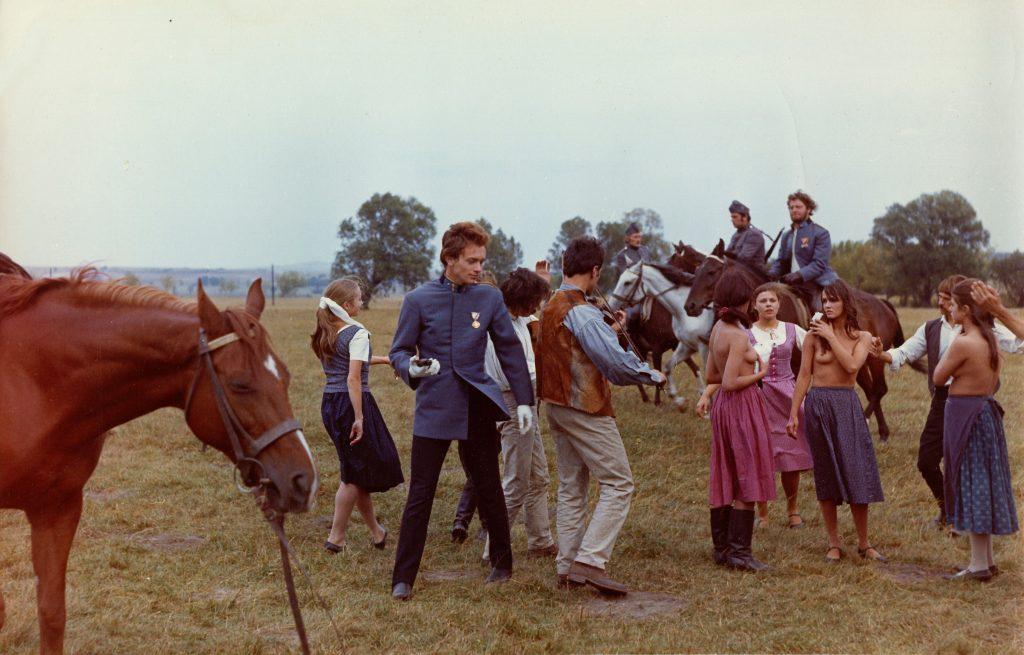The work of Hungarian film director Miklós Jancsó is little known to most American filmgoers, yet he has been championed by Martin Scorsese and others who admire his unique mastery of long, highly choreographed takes and his commitment to political film.
In 2020 six of Jancsó’s films were restored by the Hungarian National Film Archive and they begin a theatrical run at New York City’s Metrograph theater January 14: Red Psalm, Winter Wind, Electra, My Love, The Confrontation, The Red and The White and The Round-Up. Two of them, The Round-Up and Electra, My Love, will be streaming on Metrograph’s streaming service.
Writing about Jancsó last month, Scorsese said: “One of the major preoccupations of [the sixties] was the need to make a genuinely political cinema. What should a political film cinema be? Should it look to past, to the great Soviet films? Or to the plays and writings of Bertolt Brecht? Should it be rousing and melodramatic, or icy and analytical? Was Jean-Luc Godard the answer? Alain Resnais? Chris Marker? Of course there was no definitive answer. There were only individual responses, from individual artists.”
For Jancsó, that response was to write scenarios set in historical episodes from the history of his country that show the cost and reality of populist uprisings, civil wars and revolutions. His 1967 film “The Red and the White” was funded by both Hungary and Russia to commemorate the 50th anniversary of the October Revolution in Russia. Jancsó, however, set it in 1919, during the disastrous civil war that broke out between the Bolsheviks (the Red) and the Tsarist “Whites.” People are often confused by the film because there are no central characters, no singular heroes. Even the nurses who seem to represent an apolitical humanity because of their allegiance to the hippocratic oath are capable of shifting loyalties in desperate moments. The movements of the troops are chaotic. Atrocities are punctuated by odd humiliations, like the sequence in which a group of Tsarist soldiers make the nurses put on dresses and dance and then let them go. There is no attempt to make the deaths realistic; no squibs exploded with spurting blood, no blood at all, as if the film was shot in the 1930s instead of the 1960s. Like Godard, Jancsó believes that realistic gore becomes a spectacle whose catharsis of violence numbs audiences into a non-political reaction to what they see.

Besides discouraging audience identification with anyone or any side, Jancsó employs long takes filmed on the flat steppes of the region, here on both sides of the Volga river. Filmed in black and white Cinemascope, the frame is often filled with a vast landscape with soldiers far in the distance and then he has other soldiers enter closer to the camera, horses circling around soldiers in the middle, always moving the camera to create different compositions. Killings often occur in the distance or off-screen. Though poorly received in Russia, the film was a contender for the top award at the 1968 Cannes Film Festival but the festival was shut down that year because of the May 1968 protests.
By 1973’s “The Red Psalm” he was working in color, using it for symbolic effect in this highly choreographed, musical account of a doomed peasant revolt in Hungary in 1890. There are only 26 shots in this 84-minute film but rather than being merely an audacious formal exercise it dazzles with an outdoor, ritualized ceremony of the joys and sorrows of collective action by the poor. Some critics regard this as his best film and it won Jancsó the Best Director award at Cannes in 1972.

Jancsó also made several films in Italy and urban Budapest and continued working until 2010. He died in 2014 at age 92. His fellow Hungarian director Béla Tarr has called him, “The greatest Hungarian film director of all time.”
